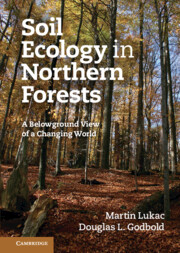Book contents
- Frontmatter
- Contents
- Preface
- 1 Introduction
- 2 Soil properties
- 3 Forest soil development and classification
- 4 Soil fungi
- 5 Soil water
- 6 Forest carbon cycle
- 7 Nutrient cycling
- 8 Northern forests in a high-CO2 world
- 9 Soil acidity and heavy metal pollution
- 10 Nitrogen
- 11 Soil functioning and climate change
- References
- Index
- Plate section
3 - Forest soil development and classification
Published online by Cambridge University Press: 26 April 2011
- Frontmatter
- Contents
- Preface
- 1 Introduction
- 2 Soil properties
- 3 Forest soil development and classification
- 4 Soil fungi
- 5 Soil water
- 6 Forest carbon cycle
- 7 Nutrient cycling
- 8 Northern forests in a high-CO2 world
- 9 Soil acidity and heavy metal pollution
- 10 Nitrogen
- 11 Soil functioning and climate change
- References
- Index
- Plate section
Summary
The development of forest soils is a continuing and complex process during which climate, vegetation and the emergent soil influence each other. Thousands of years pass before forest soil is fully developed, but owing to continuously changing climate conditions this process is never finished as the soil adjusts to each new environment. All three factors form an interdependent complex: when one of them changes the remaining two are altered before a new equilibrium is reached. Continuity of forest cover over a developing soil usually results in well-defined stratification of the soil profile. The layering of soil horizons reflects the physical and chemical characteristics of the parent rock, the prevailing vegetation and the amount of time that has passed since soil development was initiated.
Eventually, a series of differentiated soil horizons typical of a forest soil develops. Plant and animal litter deposited onto the surface forms an organic O horizon composed exclusively of organic matter in increasingly advanced stages of decomposition with increasing depth. Mixing of organic matter with the mineral fraction leads to the development of an A horizon, typically dark or black in colour with a high nutrient content. The A horizon is sometimes followed by an E (eluvial) horizon, a nutrient-poor layer of bleached mineral fraction, which forms in soils where sufficient precipitation causes leaching and removal of chemical compounds.
- Type
- Chapter
- Information
- Soil Ecology in Northern ForestsA Belowground View of a Changing World, pp. 32 - 56Publisher: Cambridge University PressPrint publication year: 2011



